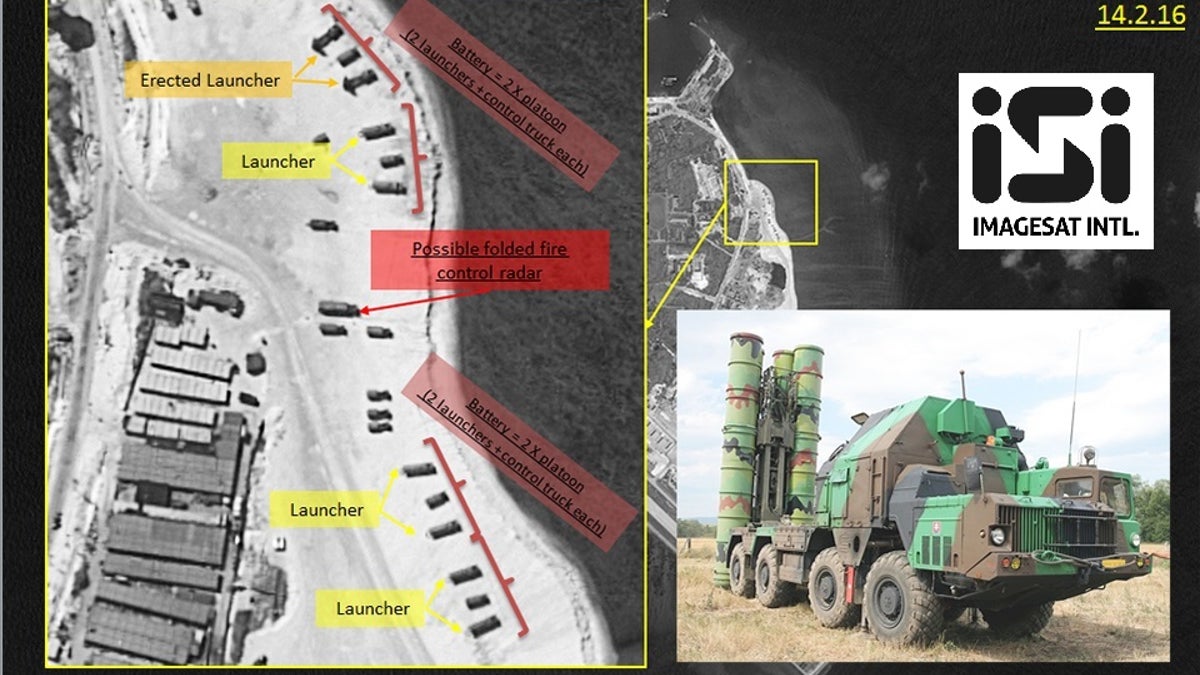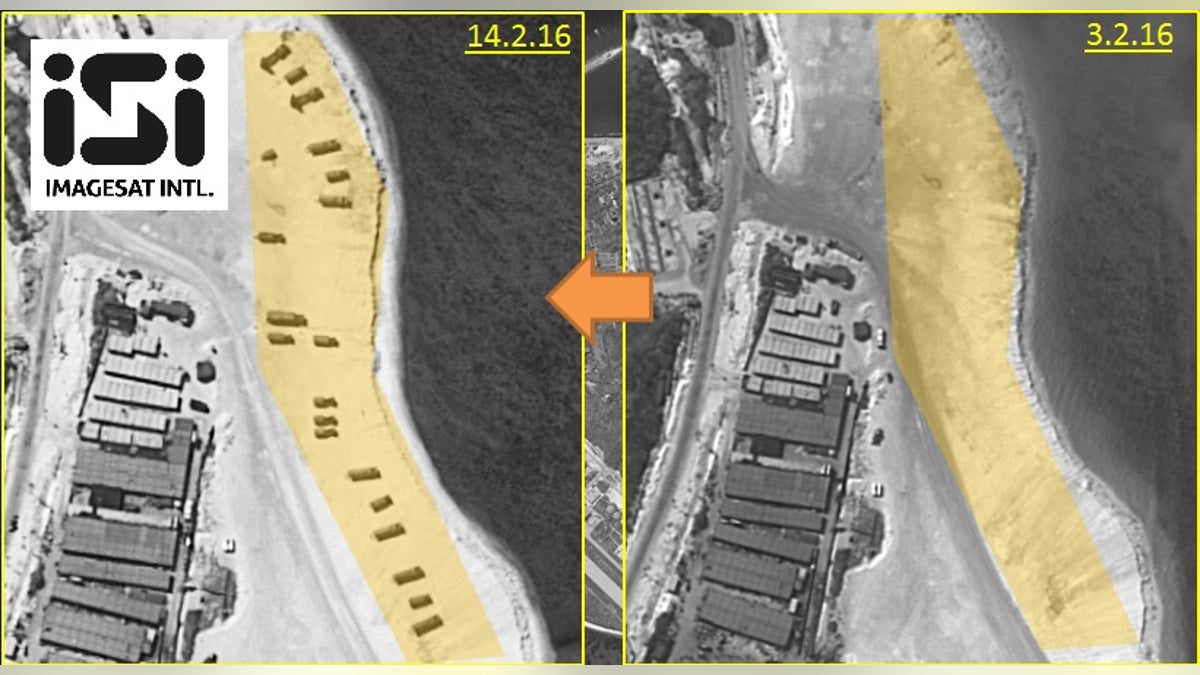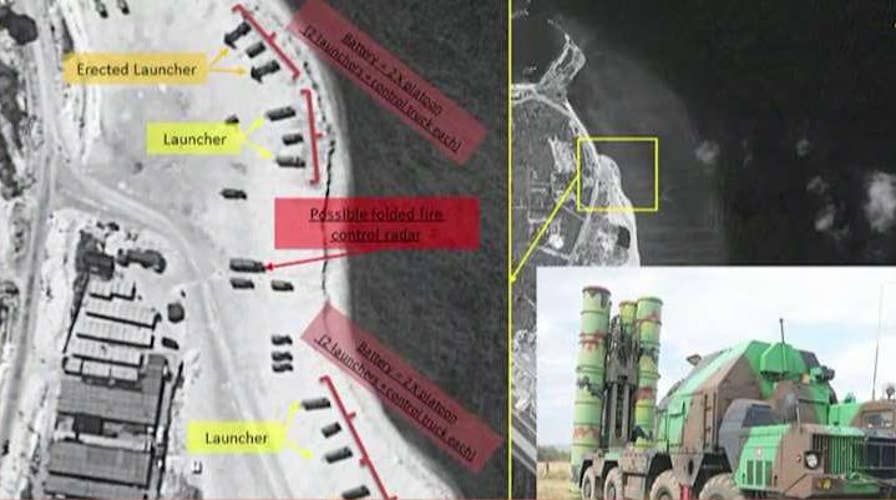Fox exclusive: China deploys missiles on contested island
Doug McKelway reports on 'Special Report'
The Chinese military has deployed an advanced surface-to-air missile system to one of its contested islands in the South China Sea according to civilian satellite imagery exclusively obtained by Fox News, more evidence that China is increasingly "militarizing" its islands in the South China Sea and ramping up tensions in the region.
The imagery from ImageSat International (ISI) shows two batteries of eight surface-to-air missile launchers as well as a radar system on Woody Island, part of the Paracel Island chain in the South China Sea.
It is the same island chain where a U.S. Navy destroyer sailed close to another contested island a few weeks ago. China at the time vowed “consequences” for the action.
Woody Island is also claimed by Taiwan and by Vietnam.

Diagram including a satellite image of the beach from Feb. 14. (ImageSat International)
The missiles arrived over the past week. According to the images, a beach on the island was empty on Feb. 3, but the missiles were visible by Feb. 14.
A U.S. official confirmed the accuracy of the photos. The official said the imagery viewed appears to show the HQ-9 air defense system, which closely resembles Russia’s S-300 missile system. The HQ-9 has a range of 125 miles, which would pose a threat to any airplanes, civilians or military, flying close by.
This comes as President Obama hosts 10 leaders from Southeast Asia -- Indonesia, Malaysia, the Philippines, Singapore, Thailand, Bruneil, Vietnam, Laos, Myanmar and Cambodia -- in Palm Springs, many of those leaders concerned over China’s recent activity in the South China Sea. "The United States will continue to fly, sail and operate wherever international law allows," Obama said Tuesday.

Images of the Woody Island beach on Feb. 14 (left) and Feb. 3. (ImageSat International)
The Pentagon was watching the developments closely, a defense official told Fox News. "The United States continues to call on all claimants to halt land reclamation, construction, and militarization of features in the South China Sea," the official said.
In the past two years, China has built over 3,000 acres of territory atop seven reefs in the area. There are a total of three runways built on three of the artificial islands.
This development comes weeks after the U.S. Navy guided-missile destroyer USS Curtis Wilbur (DDG-54) sailed within 12 nautical miles of Triton Island, part of the Paracel Island chain in the South China Sea.
The incident drew strong condemnation from China’s defense ministry who vowed there would be consequences.
A Chinese military spokesman said the U.S. warship “violated Chinese law” and was a “deliberate provocation.” The Chinese issued warnings to the U.S. ship and “expelled it swiftly,” according to a statement from Chinese Foreign Ministry spokesperson Hua Chunying. The U.S. Navy denied that any warnings took place.
The statement from the Chinese defense ministry warned sailing that close to the island “may cause extremely dangerous consequences.”
The incident in the South China Sea in late January came days after Secretary of State John Kerry visited Beijing to discuss regional issues including China’s contested islands in the South China Sea.
During a press conference in Beijing with Kerry, China’s foreign minister pledged not to "militarize" the disputed islands.
"China has given a commitment of not engaging in so-called militarization, and we will honor that commitment. And we cannot accept the allegation that China’s words are not being matched by actions," Chinese Foreign Minister Wang Yi said.
But Wang left himself some diplomatic space for the deployment of weapons to protect the islands. "There are some necessary facilities for self-defense," he added.
Kerry said the United States "does not take sides on the sovereignty questions underlying the territorial disputes."
But his Chinese counterpart was less ambiguous.
"I pointed out to Secretary Kerry that the South China Sea Islands have historically been China's territory. China has a right to protect its own territorial sovereignty," Chinese Foreign Minister Wang Yi said.
In early January, China tested one of the runways by landing two civilian airliners on Fiery Cross Reef in the Spratly island chain of islands. Pentagon officials are concerned that military aircraft could be next.
Monday, the commander of the Navy’s 7th fleet, responsible for the waters of the western Pacific, told reporters, “We are unsure where they are taking us," and urged Beijing to be more open with its military operations.
It could relieve "some of the angst we are now seeing," Vice Admiral Joseph Aucoin said, pledging that the U.S. military would continue to conduct freedom of operations missions close to the contested Chinese islands, including flying aircraft overhead.





















